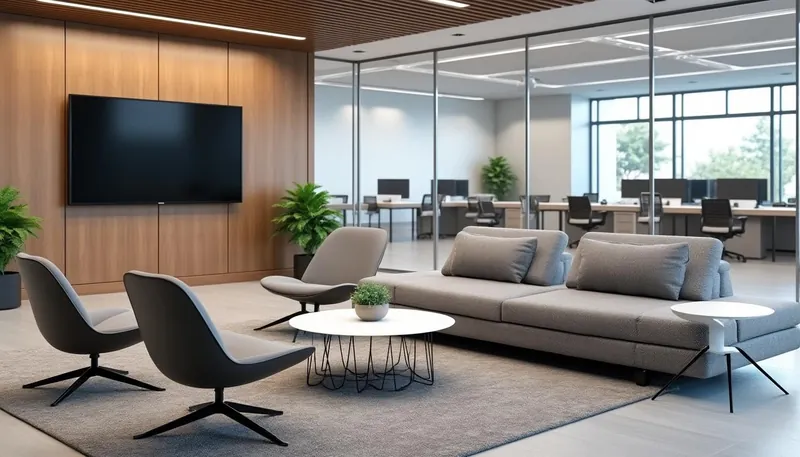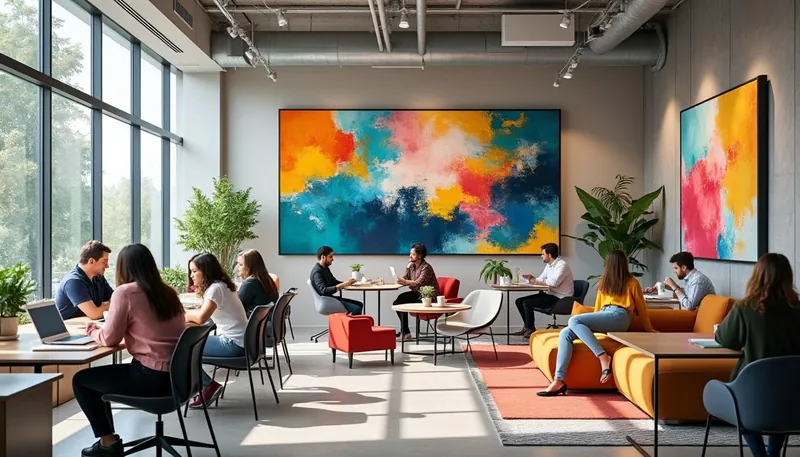In modern workplaces, the importance of effective design is continuously evolving, and one of the most noteworthy aspects is the role of breakout spaces. These versatile areas are not merely a trend; they are essential for cultivating an atmosphere that fosters creativity, collaboration, and mental rejuvenation. As employees strive to balance the demands of productivity with the need for relaxation, organizations are increasingly recognizing the value of creating dynamic environments that include designated areas for employees to gather, brainstorm, and recharge. The intricate relationship between workspace design and employee satisfaction cannot be understated, and breakout spaces serve as a bridge between structured work environments and informal relaxation. In this article, we’ll explore the multifaceted purpose of breakout spaces, the essential elements for effective design, how they encourage collaboration, and methods to maximize utilization while ensuring these areas are cohesively integrated into overall office layouts.
Brief
- Breakout spaces enhance productivity and creativity in the workplace 🌟.
- These areas function as informal settings for meetings and social interactions 🤝.
- Key elements include furniture, decor, lighting, and technology 🛋️.
- Effective management and scheduling systems ensure optimal use of breakout spaces 📅.
- Careful integration into office design reflects company culture and branding 🎨.
Understanding the Purpose of Breakout Spaces in the Workplace
The primary purpose of breakout spaces in offices is to provide an environment where employees can step away from their desks and engage in activities that foster both relaxation and creativity. These areas are not just a luxury; they are crucial for maintaining productivity levels, enhancing employee morale, and building stronger team dynamics. By offering a designated place for informal gatherings or brainstorming sessions, breakout spaces cater to the variety of needs within the modern workforce.
Indeed, the design of breakout areas greatly influences the degree to which they fulfill their purpose. Versatile designs that accommodate diverse activities can turn these spaces into valuable assets for organizations. For example, whether employees use the area for quick catch-ups, team meetings, or casual brainstorming sessions, the layout must be adaptable. A dynamic breakout area can include a variety of seating arrangements such as bean bags and lounge chairs alongside tables for discussions, establishing a balance between relaxation and productivity.
Moreover, the aesthetic elements of a breakout area—such as color schemes, lighting, and decor—play an integral role in creating an inviting atmosphere. Bright colors and natural light can invigorate the space and improve mood, while earthy tones and comfortable seating foster a more relaxed environment. It’s essential to reflect the company’s culture within these spaces, as this can motivate employees to engage more freely, ultimately leading to increased innovation.
| Function | Benefits |
|---|---|
| Relaxation | Reduces stress and prevents burnout. |
| Collaboration | Encourages teamwork and idea sharing. |
| Creativity | Inspires fresh ideas through informal settings. |
| Community | Strengthens relationships among employees. |

Key Elements of an Effective Breakout Area in the Office
When it comes to constructing an effective breakout area, several crucial elements must be taken into account. These components—furniture, decor, seating arrangements, lighting, and technology—collectively influence the functionality and comfort of the space.
Furniture choices are foundational in setting the tone for a breakout area. Modular furniture that can be easily rearranged allows flexibility based on the requirements of the moment, whether it’s for team discussions or individual relaxation. Comfortable chairs, soothing colors, and appropriately-sized tables create an inviting setting, encouraging employees to use the space regularly. Brands like Herman Miller and Steelcase offer innovative designs that combine aesthetics with functionality, which can significantly contribute to the atmosphere of the breakout area.
Decor can add a personal touch that reflects the organization’s values and culture. Engaging artwork, live plants, and inspirational quotes can breathe life into the space, stimulating creativity and positivity. The appropriate balance of vibrancy is essential; overly bright colors might overwhelm some while too muted tones can lead to a lack of stimulation.
Seating and Lighting
Variety in seating options—such as couches, stools, and even standing desks—can cater to different employee preferences, accommodating both relaxed interactions and more formal seating arrangements. Ergonomics should not be overlooked; comfortable seating can encourage longer usage without physical strain.
Lighting is a cornerstone of any effective breakout area. Leveraging natural light can energize the space and enhance employee well-being. Where natural light falls short, incorporating warm and adjustable lighting can foster a cozy atmosphere. Inappropriate lighting can impact employee mood and productivity levels, making it crucial to deliberately plan the illumination in breakout spaces.
| Element | Importance | Examples |
|---|---|---|
| Furniture | Provides comfort and versatility | Modular options from Knoll, Teknion |
| Decor | Reflects company culture | Artwork by local artists, plants from Vitra |
| Seating | Encourages prolonged use | Ergonomic chairs from Allsteel |
| Lighting | Influences mood | Natural light sources; ambient lights |

Encouraging Collaboration and Creativity with Breakout Zones
Breakout zones serve as valuable assets in promoting collaboration and creativity among employees. These spaces can be specially designed to support various team activities, enhancing their utility and importance in an office environment. The casual nature of these areas often leads to more open communication and spontaneous idea generation.
The unique setting of breakout spaces can facilitate informal meetings, unlike traditional conference rooms that might invoke formality. An open atmosphere encourages participants to share their ideas freely without the tensions typically associated with formal settings. This approach can significantly enhance group dynamics, leading to creative outcomes and solutions.
Brainstorming and Team-Building Activities
Incorporating tools like whiteboards, projector screens, and brainstorming supplies can further elevate the creative potential of breakout areas. These elements can transform the space into a hub where innovation flourishes. Moreover, scheduling distinct times for team-building activities in these areas can strengthen relationships and promote a sense of community, subsequently enhancing collaboration.
To illustrate, the use of breakout spaces for training sessions and group projects can lead to engagement that boosts the overall productivity of the team. Having access to technology like video conferencing systems and presentation equipment can allow teams to transition smoothly from brainstorming to project execution, increasing their overall effectiveness.
| Activity Type | Primary Goal | Tools Needed |
|---|---|---|
| Informal Meetings | Encourage open communication | Chairs, tables, refreshments |
| Brainstorming Sessions | Generate new ideas | Whiteboards, sticky notes, markers |
| Team-Building Activities | Strengthen team cohesion | Games, collaborative tasks |
| Training Sessions | Enhance learning engagement | Projectors, screens, technology |
Maximising the Utilisation of Breakout Spaces in the Workplace
Efficient management and effective scheduling systems are essential to ensure that breakout spaces are optimally used. A well-organized approach to booking these areas can enhance resource availability and eliminate conflicts that arise from double bookings.
Implementing a booking system is a practical first step towards efficient usage. Employees should have the capability to reserve these areas in advance, ensuring accessibility for team meetings, brainstorming sessions, or relaxation. This proactive management can discourage overcrowding and promote equitable access.
Monitoring and Maintenance
Additionally, monitoring the utilization of breakout spaces can help organizations identify patterns in use and make adjustments accordingly. By keeping track of when these spaces are in high demand, organizations can better allocate resources and optimize scheduling. Regular maintenance of the areas ensures that they remain inviting and functional, reinforcing employee engagement with these essential spaces.
Moreover, organizations can consider integrating health and wellness features into breakout spaces to enhance the overall employee experience. For instance, options for relaxation, such as yoga corners or quiet zones, can meaningfully contribute to employee well-being and productivity.
| Management Method | Description | Benefits |
|---|---|---|
| Booking Systems | Allows pre-reservation of spaces | Reduces conflicts, ensures access |
| Monitoring Usage | Tracks patterns in space utilization | Better resource allocation |
| Regular Maintenance | Ensures cleanliness and functionality | Keeps spaces inviting |
| Health Features | Incorporates wellness elements | Enhances well-being and productivity |
Incorporating Breakout Areas into the Overall Office Design
The integration of breakout areas into the overall office layout is a vital part of modern workplace design. Strategic placement within the office can promote accessibility while ensuring these spaces are contextualized within the broader environment of the workspace.
Layout Considerations
Considering the flow of the office, breakout areas should ideally be located near common high-traffic zones, such as kitchens or main pathways. This proximity promotes frequent use while also affording a sense of privacy when needed. Utilizing dividers, plants, or distinct flooring changes can create a visual separation while still maintaining an open environment.
Moreover, zoning within breakout spaces allows organizations to designate specific areas for various functionalities. This could involve creating distinct zones for relaxation, collaboration, or focused work, ensuring that the space offers a variety of experiences to suit diverse employee needs.
| Design Consideration | Reason | Possible Implementation |
|---|---|---|
| Flow of Office | Encourages use by being accessible | Place near kitchens or main walkways |
| Visual Separation | Provides privacy and reduces noise | Use of plants or flooring transitions |
| Zoning | Diverse functionalities within the space | Create areas for relaxation vs. collaboration |
| Brand Reflection | Enhances company culture | Utilize colors or elements that reflect branding |
What are breakout spaces?
Breakout spaces are designated areas in the office designed for relaxation, collaboration, and creativity, allowing employees to step away from their workstations.
Why are breakout spaces important?
They enhance employee well-being, promote creativity, and foster collaboration within teams, ultimately leading to higher productivity.
How can I create an effective breakout space?
Focus on versatile furniture, engaging decor, appropriate lighting, and integrate technology to accommodate various activities.
What should be included in a breakout area?
Include comfortable seating, adequate lighting, decor that reflects company culture, and technology for presentations or meetings.
How do I manage the utilization of breakout spaces?
Implement booking systems, monitor usage patterns, and perform regular maintenance to ensure the spaces remain functional and accessible.


